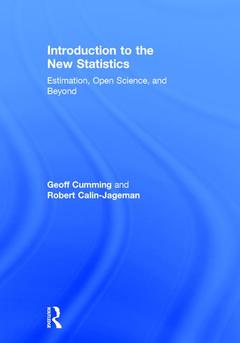Introduction to the New Statistics Estimation, Open Science, and Beyond
Auteurs : Cumming Geoff, Calin-Jageman Robert

This is the first introductory statistics text to use an estimation approach from the start to help readers understand effect sizes, confidence intervals (CIs), and meta-analysis (?the new statistics?). It is also the first text to explain the new and exciting Open Science practices, which encourage replication and enhance the trustworthiness of research. In addition, the book explains NHST fully so students can understand published research. Numerous real research examples are used throughout. The book uses today?s most effective learning strategies and promotes critical thinking, comprehension, and retention, to deepen users? understanding of statistics and modern research methods. The free ESCI (Exploratory Software for Confidence Intervals) software makes concepts visually vivid, and provides calculation and graphing facilities. The book can be used with or without ESCI.
Other highlights include:
- Coverage of both estimation and NHST approaches, and how to easily translate between the two.
- Some exercises use ESCI to analyze data and create graphs including CIs, for best understanding of estimation methods.
-Videos of the authors describing key concepts and demonstrating use of ESCI provide an engaging learning tool for traditional or flipped classrooms.
-In-chapter exercises and quizzes with related commentary allow students to learn by doing, and to monitor their progress.
-End-of-chapter exercises and commentary, many using real data, give practice for using the new statistics to analyze data, as well as for applying research judgment in realistic contexts.
-Don?t fool yourself tips help students avoid common errors.
-Red Flags highlight the meaning of "significance" and what p values actually mean.
-Chapter outlines, defined key terms, sidebars of key points, and summarized take-home messages provide a study tool at exam time.
-http://www.routledge.com/cw/cumming offers for students: ESCI downloads; data sets; key term flashcards; tips for using SPSS for analyzing data; and videos. For instructors it offers: tips for teaching the new statistics and Open Science; additional homework exercises; assessment items; answer keys for homework and assessment items; and downloadable text images; and PowerPoint lecture slides.
Intended for introduction to statistics, data analysis, or quantitative methods courses in psychology, education, and other social and health sciences, researchers interested in understanding the new statistics will also appreciate this book. No familiarity with introductory statistics is assumed.
1. Asking and Answering Research Questions 2. Research Fundamentals: Don’t Fool Yourself 3. Picturing and Describing Data 4. The Normal Distribution and Sampling 5. Confidence Intervals and Effect Sizes 6. p Values, Null Hypothesis Significance Testing, and Confidence Intervals 7. The Independent Groups Design 8. The Paired Design 9. Meta-Analysis 10. Open Science and Planning Research 11. Correlation 12. Regression 13. Frequencies, Proportions, and Risk 14. Extended Designs: One Independent Variable 15. Extended Designs: Two Independent Variables 16. Future Directions
Geoff Cumming is professor emeritus of La Trobe University and has been teaching statistics for over 40 years.
Robert Calin-Jageman is a professor of psychology and the neuroscience program director at Dominican University and has been teaching and mentoring undergraduate students for nine years.
Date de parution : 09-2016
17.8x25.4 cm
Disponible chez l'éditeur (délai d'approvisionnement : 14 jours).
Prix indicatif 214,69 €
Ajouter au panierDate de parution : 10-2016
17.8x25.4 cm
Thèmes d’Introduction to the New Statistics :
Mots-clés :
Independent Groups; Independent Groups Design; New statistics; Random Assignment; Estimation; Null Hypothesis; Confidence intervals; Open Science; Meta-analysis; Data Set; Effect size; Paired Design; Difference Axis; Introductory statistics; Fi De; Cohen’s d; Open Science Practices; Regression; Ab Ilit; Correlation; Population SD; ANOVA; Population Effect Size; ESCI; Variability Component; Scatterplots; Cat’s Eye; Inferential statistics; Standardized Effect Size Estimate; Descriptive statistics; NHST Approach; Ig Ns; Sampling Variability; High School GPA; Body Satisfaction; Transcription Score; Short CI; Equal Interval Assumption; Random Effects Meta-analysis



